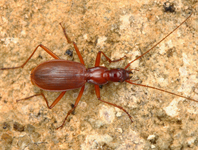Abstract
We describe a brackish-water calanoid copepod Acartia (Acanthacartia) cagayanensis sp. nov. collected from river estuaries in the northernmost Luzon, the Philippines. The new species has several characteristic features that are typical to the A. plumosa group (A. (A.) plumosa Scott T., 1894, A. (A.) sinjiensis Mori, 1940 and A. (A.) tropica Ueda & Hiromi, 1987); specifically, a short apical spine on the long terminal segment of male left leg 5, which is unique to the group. The morphological features of A. cagayanensis sp. nov. different from those of the A. plumosa group are the barrel-shaped genital double somite and the cylindrical basal part of the terminal segment of female leg 5. Among the species in the group, A. cagayanensis sp. nov. is closest to A. sinjiensis in terms of the spinule patterns on the female antennule, the posterior corner of the prosome, and the male second urosomite. The genetic analysis using DNA sequences of mitochondrial gene cytochrome oxidase subunit I (COI) revealed that A. sinjiensis from Japan and A. cagayanensis sp. nov. differed by 16.5–16.9%, in contrast to a small variation (0.0–0.5%) within each population. We confirmed that previous records of A. sinjiensis from the Philippines were not A. cagayanensis sp. nov., and therefore, A. cagayanensis sp. nov. is the third species of the subgenus Acanthacartia Steuer, 1925, after A. sinjiensis and A. (A.) tsuensis Ito, 1956.
References
Bradford-Grieve, J.M. (1999) The Marine Fauna of New Zealand: Pelagic calanoid copepoda: Bathypontiidae, Arietellidae, Augaptilidae, Heterorhabdidae, Lucicutiidae, Metridinidae, Phyllopodidae, Centropagidae, Pseudodiaptomidae, Temoridae, Candaciidae, Pontellidae, Sulcanidae, Acartiidae, Tortanidae. NIWA Biodiversity Memoir 111. Niwa, Wellington, 268 pp.
Boxshall, G.A. & Halsey, S.H. (2004) An Introduction to Copepod Diversity. The Ray Society, London, 966 pp.
Chen, G. & Hare, M.P. (2008) Cryptic ecological diversification of a planktonic estuarine copepod, Acartia tonsa. Molecular Ecology, 17, 1451–1468.
https://doi.org/10.1111/j.1365-294X.2007.03657.x
Folmer, O., Black, M., Hoeh, W., Lutz, R. & Vrijenhoek, R. (1994) DNA primers for amplification of mitochondrial cytochrome c oxidase subunit I from diverse metazoan invertebrates. Molecular Marine Biology and Biotechnology, 3, 294–299.
Golez, M.S.N., Ohno, A., Toledo, J.D., Tanaka, Y. & Ishimaru, T. (2002) Population dynamics of the calanoid copepod, Acartia tsuensis in a brackish-water pond in the Philippines. Fisheries Science, 68, 341–344.
https://doi.org/10.2331/fishsci.68.sup1_341
Kumar, S., Stecher, G., Li, M., Knyaz, C. & Tamura, K. (2018) MEGA X: Molecular evolutionary genetics analysis across computing platforms. Molecular Biology and Evolution, 35, 1547–1549.
https://doi.org/10.1093/molbev/msy096
Larkin, M.A., Blackshields, G., Brown, N.P., Chenna, R., Mcgettigan, P.A., McWilliam, H., Valentin, F., Wallace, I.M., Wilm, A., Lopez, R., Thompson, J.D., Gibson, T.J. & Higgins, D.G. (2007) Clustal W and Clustal X version 2.0. Bioinformatics, 23, 2947–2948.
https://doi.org/10.1093/bioinformatics/btm404
Liu, C., Lin, Y., Cao, W. & Fang, L. (2008) Comparative studies of mitochondrial COI sequence between two kinds of Acartia species from Xiamen waters. Journal of Xiamen University, Natural Science, 47, 419–425. [in Chinese with English abstract]
Metillo, E. (2012) Species of copepods (Crustacea: Copepoda) from northern Mindanao nearshore waters. Mindanao Forum, 25, 1–61.
Ohtsuka, S. & Ueda, H. (1999) Zoogeography of pelagic copepods in Japan and its adjacent waters. Bulletin of Plankton Society of Japan, 46, 1–20. [in Japanese with English abstract]
Ohtsuka, S., Ueda, H. & Lian, G. (1995) Tortanus derjugini Smirnov (Copepoda: Calanoida) from the Ariake Sea, western Japan, with notes on the zoogeography of brackish-water calanoid copepods in East Asia. Bulletin of Plankton Society of Japan, 42, 147–162.
Razouls, C., de Bovée, F., Kouwenberg, J. & Desreumaux, N. (2005–2020) Diversity and geographic distribution of marine planktonic copepods. Sorbonne University, CNRS. Available from: http://copepodes.obs-banyuls.fr/en (accessed 16 April 2020)
Ronquist, F., Teslenko, M., Van Der Mark, P., Ayres, D.L., Darling, A., Höhna, S., Larget, B., Liu, L., Suchard, M.A. & Huelsenbeck, J.P. (2012) Mrbayes 3.2: Efficient bayesian phylogenetic inference and model choice across a large model space. Systematic Biology, 61, 539–542.
https://doi.org/10.1093/sysbio/sys029
Sakaguchi, S.O. & Ueda, H. (2010) A new species of Pseudodiaptomus (Copepoda: Calanoida) from Japan, with notes on the closely related P. inopinus Burckhardt, 1913 from Kyushu Island. Zootaxa, 2623, 52–68.
https://doi.org/10.11646/zootaxa.2623.1.2
Sakaguchi, S.O. & Ueda, H. (2018) Genetic analysis on Pseudodiaptomus inopinus (Copepoda, Calanoida) species complex in Japan: revival of the species name of P. japonicus Kikuchi, 1928. Plankton and Benthos Research, 13, 1–7.
https://doi.org/10.3800/pbr.13.173
Sakaguchi, S.O., Ueda, H., Ohtsuka, S., Soh, H.Y. & Yoon, Y.H. (2011) Zoogeography of planktonic brackish-water calanoid copepods in western Japan with comparison with neighboring Korean fauna. Plankton and Benthos Research, 6, 18–25. https://doi.org/10.3800/pbr.6.18
Srinui, K., Ohtsuka, S., Metillo, E.B. & Nishibori, M. (2019) A new species of Acartia (Copepoda, Calanoida) from the Philippines, based on morphological and molecular analyses. ZooKeys, 814, 71–94.
https://doi.org/10.3897/zookeys.814.24601
Steuer, A. (1923) Bausteine zu einer Monographie der Copepodengattung Acartia. Arbeiten aus den Zoologischen Institut der Universität Innsbruck, 1, 91–144.
Ueda, H. & Bucklin, A. (2006) Acartia (Odontacartia) ohtsukai, a new brackish-water calanoid copepod from Ariake Bay, Japan, with a redescription of the closely related A. pacifica from the Seto Inland Sea. Hydrobiologia, 560, 77–91.
https://doi.org/10.1007/s10750-005-9513-0
Ueda, H. & Hiromi, J. (1987) The Acartia plumosa T. Scott species group (Copepoda, Calanoida) with a description of A. tropica n. sp. Crustaceana, 53, 225–236.
https://doi.org/10.1163/156854087X00312
Ueda, H. & Sakaguchi, S.O. (2019) Pseudodiaptomus yamato n. sp. (Copepoda, Calanoida) endemic to Japan, with redescriptions of the two closely related species P. inopinus Burckhardt and P. japonicus Kikuchi. Plankton and Benthos Research, 14, 29–38.
https://doi.org/10.3800/pbr.14.29
Walter, T.C. & Boxshall, G. (2019) World of Copepods database. Acartia (Acanthacartia) Steuer, 1915. Available from: http://www.marinespecies.org/copepoda/aphia.php?p=taxdetails&id=149738 (accessed 16 April 2020)


